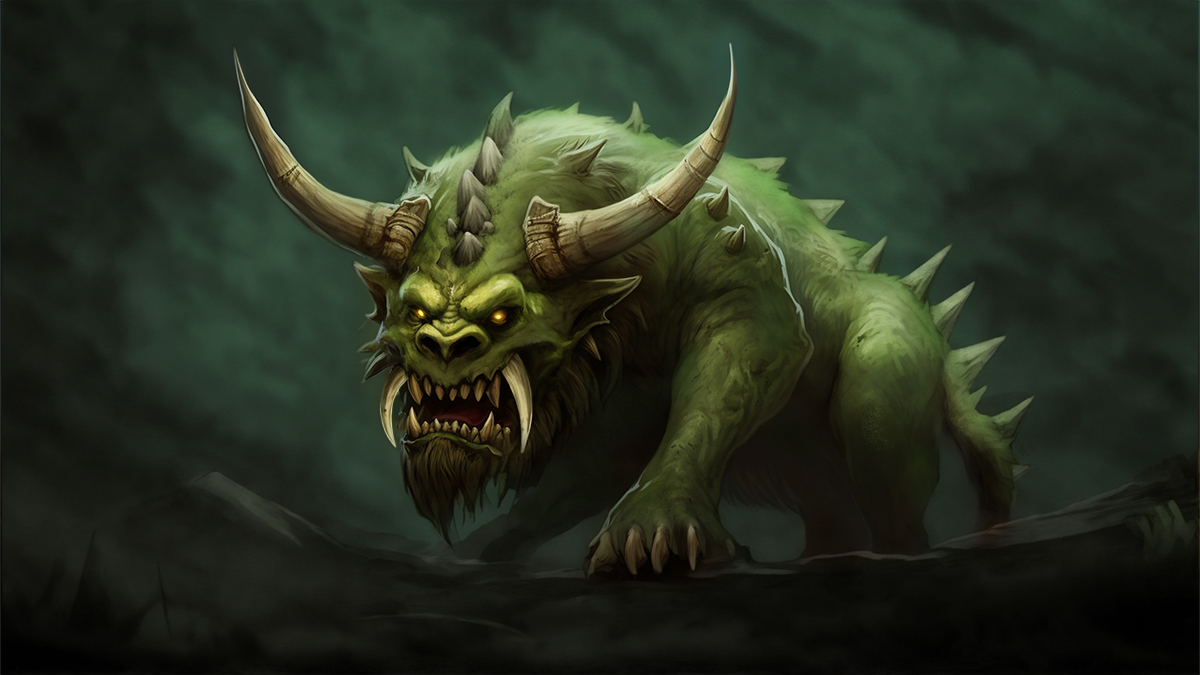The Hodag is a so-called “fearsome critter” said to resemble an ox but with a frog-like head. The fabled beast is unique to the area of Rhinelander, Wisconsin, and has been part of local legend for a long time.
Description
Although the Hodag had been part of Rhinelander’s lore for as long as anyone could recall, no one actually saw one until 1893.
The lumberjacks of the area maintained that the Hodag was the living embodiment of dead oxen who were angry at one particular lumberjack for forcing them to work like slaves when they were alive.
Accordingly, the beast was said to be sizeable, with a huge frog-like head and powerful body.
Hodags were known to disturb the lumberjacks while they worked and were also known for eating the white bulldogs of the area.
Sightings and Tales
Eugene Shepard was a local real estate agent involved in the timber trade. He was walking home through the forest one day, as was his usual habit when he claimed to have come across a Hodag.
He described the creature as being 7 feet long and estimated that it weighed around 200 pounds. He said it looked like a giant lizard with extremely sharp teeth and had terrific spikes protruding along its back.
The beast had short hair all over its body, short but strong legs, and long horns attached to its huge head. Apparently, it even had the grinning face of an elephant.
In a 1893 article, Shepard later called the creature a “terrible brute,” and wrote “[it] assumes the strength of an ox, the ferocity of a bear, the cunning of a fox and the sagacity of a hindoo snake, and is truly the most feared animal the lumbermen come in contact with.”
Fearing for his life, Eugene returned to town and told the townspeople of his encounter. After hearing his description, the crowd began to talk of the legend of the Hodag.
Eugene and some of the townspeople went into the forest and hunted the creature. Upon finding it, they decided to set their dogs on it to tire it out.
The dogs stood no chance against the mighty beast and were soon torn apart. The creature gobbled up one of the lumberjack’s white bulldogs, and legend says that this was when the Hodag developed a taste for white bulldogs.
Alarmed, the group fired at the beast with their guns, but this seemed to have little or no effect on the rampant Hodag.
Becoming increasingly desperate, they used dynamite to try to finally kill the Hodag. After some time – and having set the surrounding area on fire – the beast was at last dead.
Vindicated, the group took the burnt carcass back to town and put it on display. Bizarrely though, the Hodag is said to be impervious to fire, casting doubt in some quarters about the story’s veracity.
Another version of the tale claims that the hunters managed to capture the beast and tie it up, but it escaped during the night.
No other activity was recorded until three years later when Eugene informed the town that he had found another Hodag and planned to ensnare it.
With the help of a few of his neighbors, Eugene captured the beast by asphyxiating it with a chloroform-soaked rag. The group took the sleeping beast back to town and put it into a large pit.
Coincidentally, the capture of the second Hodag happened just before the Oneida County Fair, where Eugene would be able to show off the monster and, of course, make some money.
This proved successful, so Eugene decided to take his show on the road, attending many local fairs to let people see the terrifying Hodag.
Once he had returned home, he put the Hodag on display at his own property, where anyone could see it for a dime.
After a time, Eugene’s Hodag was revealed by the Smithsonian Institution as a hoax – nothing more than a carving with cattle horns and a few wires to create the illusion of movement.
It is unclear whether or not the original Hodag was real, but a photograph of this beast was released to the media. So was the whole thing a hoax, or was there a Hodag loose in the forest in 1893?
Regardless, the town of Rhinelander became a place for people to visit as a result, with the legend of the Hodag proving to be an effective revenue generator for local businesses.
In fact, Rhinelander became known as Hodag City and owes much of its prosperity to Eugene Shepard and the elusive Hodag.
People still flock to the area in the hope of seeing a Hodag, and sightings are recorded to this day.
| Other Name/s | fearsome critter |
| Location | United States, |
| Type | Hybrid |
| Habitat | Forest |
References
exemplore.com, “Hodag Monster: Urban Legend or Real-Life Cryptid?” accessed October 11, 2017,
pinebarrensinstitute.com, “Quick Cryptid Snippet: Hodag,” accessed October 11, 2017,
listverse.com, “10 Cryptids That Were Proven False,” accessed October 11, 2017,
monstrumathenaeum.org, “THE HODAG,” accessed October 11, 2017,
https://www.wausaudailyherald.com/story/news/2018/10/03/rhinelander-hodag-outlandish-story-wisconsins-mythical-beast-125-anniversary/806888002/, “Hodag: The outlandish story of Wisconsin’s mythical beast, on its 125th birthday,” accessed March 2, 2023.

[…] out the Hodag page for more […]